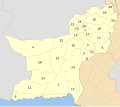This article has multiple issues. Please help improve it or discuss these issues on the talk page . (Learn how and when to remove these messages)
|
City Districts of Pakistan are districts in Pakistan are primarily comprising urban areas, such as a mega city or large metropolitan areas. Out of the 150 total districts in Pakistan, only 8 were designated as "city districts" in 2001. These city districts have administrative boards responsible for specific areas of governance within their jurisdictions. The degree of administrative autonomy varies significantly among these districts.





